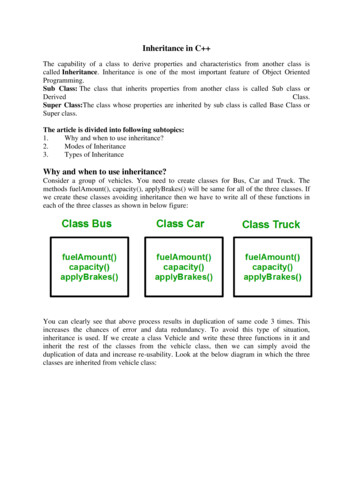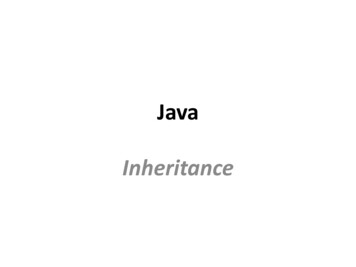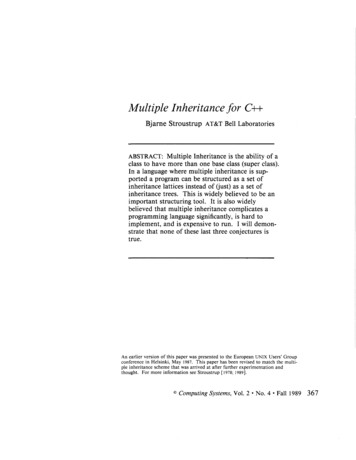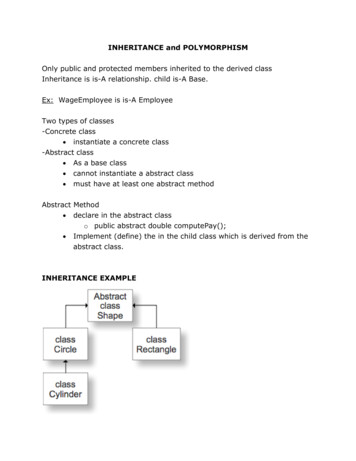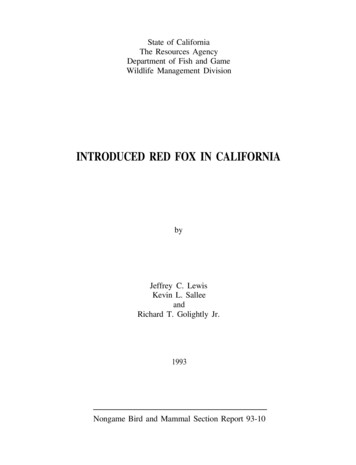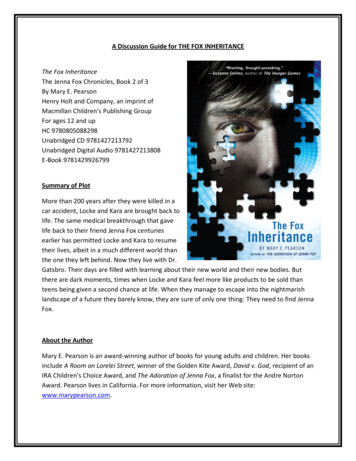
Transcription
A Discussion Guide for THE FOX INHERITANCEThe Fox InheritanceThe Jenna Fox Chronicles, Book 2 of 3By Mary E. PearsonHenry Holt and Company, an imprint ofMacmillan Children’s Publishing GroupFor ages 12 and upHC 9780805088298Unabridged CD 9781427213792Unabridged Digital Audio 9781427213808E‐Book 9781429926799Summary of PlotMore than 200 years after they were killed in acar accident, Locke and Kara are brought back tolife. The same medical breakthrough that gavelife back to their friend Jenna Fox centuriesearlier has permitted Locke and Kara to resumetheir lives, albeit in a much different world thanthe one they left behind. Now they live with Dr.Gatsbro. Their days are filled with learning about their new world and their new bodies. Butthere are dark moments, times when Locke and Kara feel more like products to be sold thanteens being given a second chance at life. When they manage to escape into the nightmarishlandscape of a future they barely know, they are sure of only one thing: They need to find JennaFox.About the AuthorMary E. Pearson is an award‐winning author of books for young adults and children. Her booksinclude A Room on Lorelei Street, winner of the Golden Kite Award, David v. God, recipient of anIRA Children’s Choice Award, and The Adoration of Jenna Fox, a finalist for the Andre NortonAward. Pearson lives in California. For more information, visit her Web site:www.marypearson.com.
Discussion Questions1. What is the significance of the title of the book? What might the inheritance of JennaFox be literally? Figuratively?2. Locke refers to himself and Kara as being part of Dr. Gatsbro’s “collection.” What doeshe mean? How can Locke and Kara be objects within a collection? Have you ever felt asif you were “on display” as Locke and Kara do? Describe that situation.3. The author does not provide many details about the world as it exists 260 years afterthe accident that took the physical lives of Locke and Kara. Hints about changes aregiven at various points in the novel. Based on clues from Locke’s early observations,what conclusions can be drawn about life in this future society? How does the authorflesh out the details as Locke and Kara travel to the “outside”?4. Dr. Gatsbro collects orchids and doorknobs among other things. Think about the literaland figurative significance of each object. What might these two interests reveal abouthis character and why?5. In this future world, humans can opt for a life span of more than 100 years because ofadvances in medicine and health. Discuss what problems might be associated withlonger life spans (i.e., overpopulation).6. In the opening chapters, what clues does Locke provide the reader about his and Kara’scondition? How about the time they spent in the “black cubes”?7. Why does Kara not want to see the cubes, while Locke feels he must? How does this onedecision indicate the difference that divides the two despite their obvious connections?8. Dr. Gatsbro has provided a narrative—a story—for Locke and Kara to explain their newexistence. What elements are true? Which parts of the story serve to gloss overunpleasant aspects of their life and creation? Why has the doctor been so careful to giveLocke and Kara these stories?9. The first two sections of the novel, THE ESTATE and THE OUTSIDE, end with shatteringevents. How do these two events foreshadow what is to come?10. Through Locke’s narration, we see how technology has shaped the future world. How dothese technological advances (Beebots, robots, transportation grids, etc.) help establishthe setting more fully?11. Locke has disturbing dreams. In one, he is choking Jenna over and over with his barehands. What importance does this dream have? How does it foreshadow events tocome once Locke and Kara are reunited with Jenna?12. As Locke continues on his journey to find Jenna in California, he discovers that airtransportation is severely restricted and that most people travel by other means. Whatcould have occurred over the intervening 200 years to create this type oftransportation system?
13. ID cards are key. No one is free to travel from one place to another without a valid IDcard. Of course, this poses some problems for Locke and Kara until they are able toobtain IDs that are not their own. In contemporary society, there has been a great dealof debate about ID and voting rights. How does this parallel with what is happening inthe future world of Jenna, Locke, and Kara?14. Locke, Kara, and Jenna go to a bazaar to do some shopping. Given the existence of V‐adsand other technologies, why do bazaars still exist? What purpose do they serve?15. On page 265, Locke observes that there is a line between miracle and monster. Whatdoes he mean by this? Are Locke, Kara, and Jenna miracles or monsters? Or acombination of both? Defend your response.16. Pearson does not reveal the entire account of the car accident that killed Locke, Kara,and Jenna. Instead, she reveals some of the events a bit at a time. Why does the authorelect to do this? What purpose does it serve?17. Euphemisms abound in the story. Release and recycle are just two examples of wordswhose real meaning is much more sinister than the way in which the word is used. Whatdo these words really mean? Why are euphemisms being used?Activities1. Ask students to examine the cover of the book prior to reading the novel. Ask them tojot down words they associate with jigsaw puzzles (or puzzles of any kind). As they readthe book, they should be directed to come back to this list of words and provideexamples from the book that illustrate the words on the list.2. Show students the title of the book and ask them to brainstorm a list of things thatcould be inherited (traits such as eye color, possessions from an estate, etc.). Give thema brief synopsis of The Adoration of Jenna Fox and ask them to select things from the listthey think might play a role in this novel.3. Locke used to recite lines of poetry to Kara and Jenna. Several of them are references inthe novel (e.g., p. 57, p. 255). Ask students to locate the poems from which the lines aretaken (the school librarian can assist with reference tools). How do these poems parallelthe characters and events of the novel?4. In Part II: THE OUTSIDE, we begin to see more and more of the technological advancesof the new world in which Locke and Kara find themselves. Create a chart or diagramwhere students can add gadgets and inventions as they surface in the story. In groups,ask students to create categories into which to divide the advances (for example:clothing, transportation, fuel, housing). After the categories have been established,different groups can create a visual which illustrates the category they have been
assigned. Projects could utilize Voice Thread, Wordle, Animoto, Prezi, and/or PowerPoint.5. Science fiction, though related to the genre of fantasy, does have roots in reality. Inreading notebooks, invite students to keep a chart of some of the “fiction” that has afirm basis in reality. For instance, the 2112 Civil War was one where the country splitalong party lines. How is that realistic and fantastic?Related Web sites:For more information about the bioethical issues raised in The Fox Inheritance abases/databases ch/resources/bioethicsFor more information about artificial intelligence and robotics, .net/http://www.howstuffworks.com/robot.htm
Related booksHere are several other titles that also deal with some of the themes, issues, and topics of TheFox Inheritance:The Adoration of Jenna Fox (The Jenna Fox Chronicles, Book 1 of 3)Little Brother by Cory DoctorowFeed by M. T. AndersonFox Forever (The Jenna Fox Chronicles Book 3)Frankenstein by Mary ShelleyGirl Parts by John M. CusickIf I Stay by Gayle FormanThe Giver by Lois LowryGuide prepared by: Teri S. Lesesne, professor, Department of Library Science, Sam HoustonState University.
The Fox Inheritance The Jenna Fox Chronicles, Book 2 of 3 By Mary E. Pearson Henry Holt and Company, an imprint of Macmillan Children's Publishing Group For ages 12 and up HC 9780805088298 Unabridged CD 9781427213792 Unabridged Digital Audio 9781427213808 E‐Book 9781429926799 Summary of Plot




